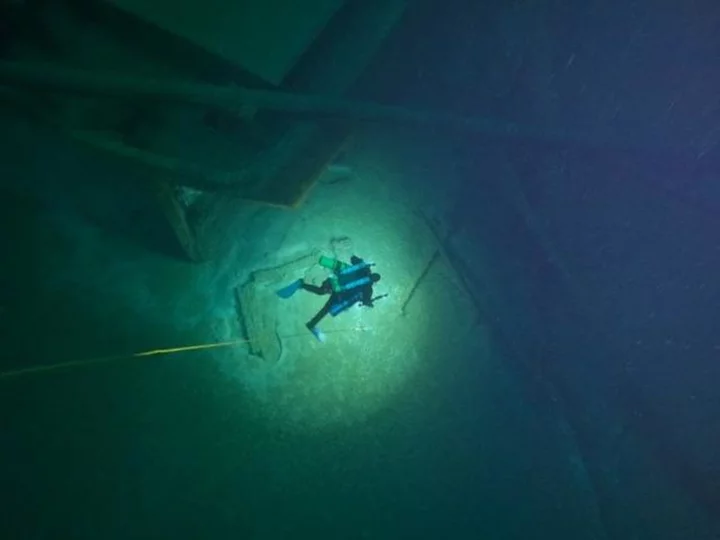BOSTON, MASSACHUSETTS: Experts have laid bare new chilling theories about why the ill-fated Titan submersible was doomed from the start of its voyage. The OceanGate Expeditions-owned vessel went missing off the North American coast in the Atlantic on June 19 when it lost contact with its mothership MV Polar Prince just an hour and 45 minutes into the dive.
An extensive rescue effort was then launched to locate the missing submersible but everything came to an end on June 22 when the US Coastal Guard confirmed that all five crew members on board the submersible had died after the vessel became subject to a "catastrophic implosion." The rescuers noted that the team spotted five major pieces of Titan’s debris 1,600 ft away from the Titanic shipwreck. The victims killed in the implosion included OceanGate CEO Stockton Rush, who piloted the vessel, British billionaire and explorer Hamish Harding, French Titanic expert Paul-Henri Nargeolet and Pakistani business tycoon Shahzada Dawood and his 19-year-old son, Suleman. As the investigation into the implosion continues, here are a few theories on what led to the Titan disaster.
Titan was dragged across rough seas
In a New York Times article, several experts compared the Titan with the Alvin, highlighting an array of design and procedural modifications that could have doomed the submersible. Alvin is a US government research submersible that has safely completed more than 4,500 deep sea dives since 1973. The research sub typically gets transported to the diving locations on the deck of a dedicated mothership, which is equipped with specialized winches and a large crane that lowers the Alvin research sub into the water.
The Titan, on the other hand, lacked a designated mothership and was pulled out to sea on the fatal dive by a smaller hired ship, the Polar Prince, in order to cut costs. Using a tow cable, the ship dragged the Titan across hundreds of miles of open sea on top of the launch platform that was used to submerge and retrieve the sub. When questioned if towing the Titan may have caused damage, a spokesperson for Oceangate said that "OceanGate is unable to provide any additional information at this time."
Titan had a pill-shape design rather than a spherical shape
At the bottom of the ocean, a sphere is an ideal shape to withstand crushing forces that can reach three tonnes per square inch because it can evenly distribute the pressure through the haul. However, if Rush had used a similar design in the Titan, he would have only been able to take two customers per trip, along with an Oceangate pilot. Instead, his Titan concept was more spacious, accommodating five passengers in the pill-shaped sub made of a carbon-fiber tube with titanium hemispheres on either end.
Former forensic metallurgist Tim Foecke told the Times that the Titan's shape may have contributed to the sub's implosion. He pointed out that the larger a sub gets, the thicker and stronger its hull must be to endure the same pressure. In two subs with the same hull thickness, the larger one would "collapse or buckle" first, he said.
Titan had a more vulnerable carbon-fiber hull
One of Rush's key innovations in the Titan was the extensive use of carbon fiber for the hull, which is cheaper and lighter than titanium. On their website, OceanGate marketed the Titan's carbon fiber and titanium endcap design as "lighter in weight and more efficient to mobilize than other deep diving submersibles." The material reduced the Titan's weight to 21,000 lbs whereas the Alvin weighs 45,000lbs. However, experts claimed that carbon composites could withstand pulling pressures far more powerfully than they can withstand crushing forces.
Foecke told the Times that he was "very surprised" by Titan's fiber structure because compression was the main force that the submersible encountered on its deep sea dives. Carbon composites also have a limited lifespan when subjected to severe pressure, according to Jasper Graham-Jones, an associate professor of mechanical and marine engineering at the University of Plymouth in the UK. "Yes, composites are extremely tough. Yes, composites are extremely long-lasting. But we do have issues with composites and the fact that composites fail in slightly different ways than other materials," he told AP.
The use of different materials in Titan increased the risk of joints dying more quickly
The Titan's design required attaching its carbon-fiber tube to the titanium endcaps, which was achieved with powerful glue. However, experts warned that maintaining control between different materials could be challenging because they change shape at different rates under pressure. Alfred S McLaren, a retired Navy submariner and president emeritus of the Explorers Club of New York City, noted that different materials in the Titan's hull had "different coefficients of expansion and compression, and that works against keeping a watertight bond."
Experts also questioned OceanGate's decision not to have the Titan undergo independent testing and certification. Graham-Jones noted that it was customary in engineering to enlist outside assistance to guarantee that vessels conform to the strictest industry requirements. In a 2019 company blog post, OceanGate criticized the third-party certification process as time-consuming and stifles innovation. "Bringing an outside entity up to speed on every innovation before it is put into real-world testing is anathema to rapid innovation," the post read.









